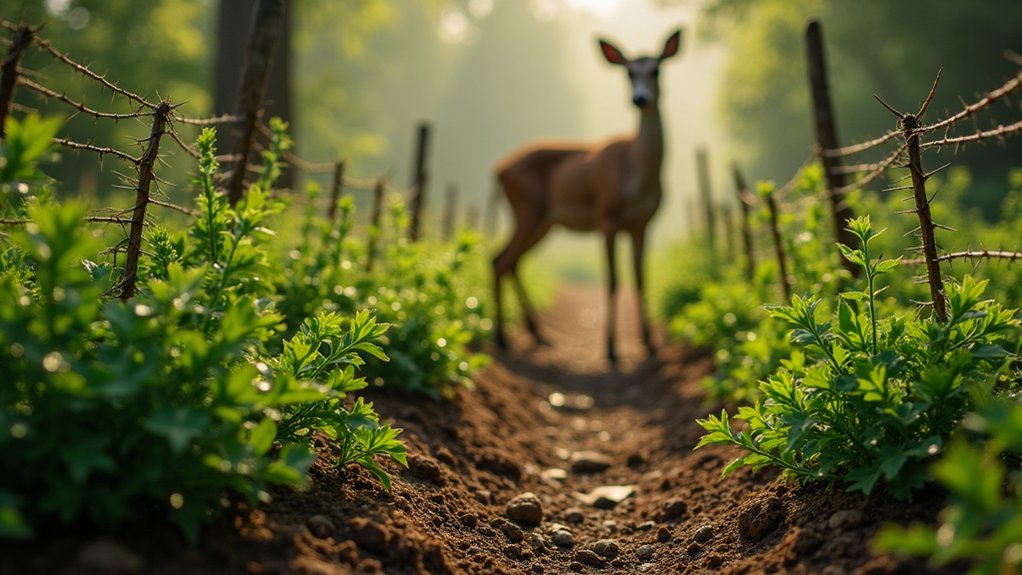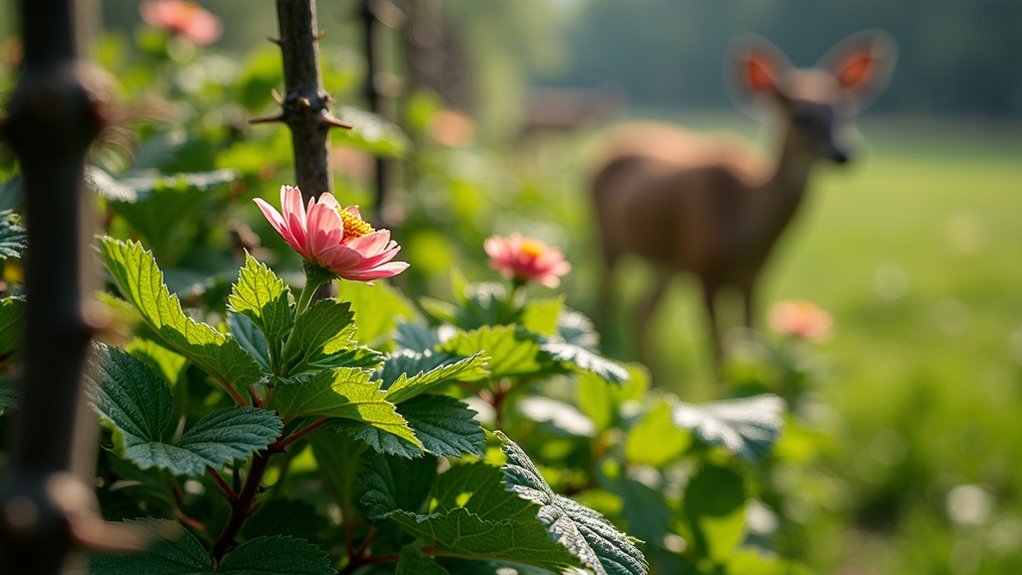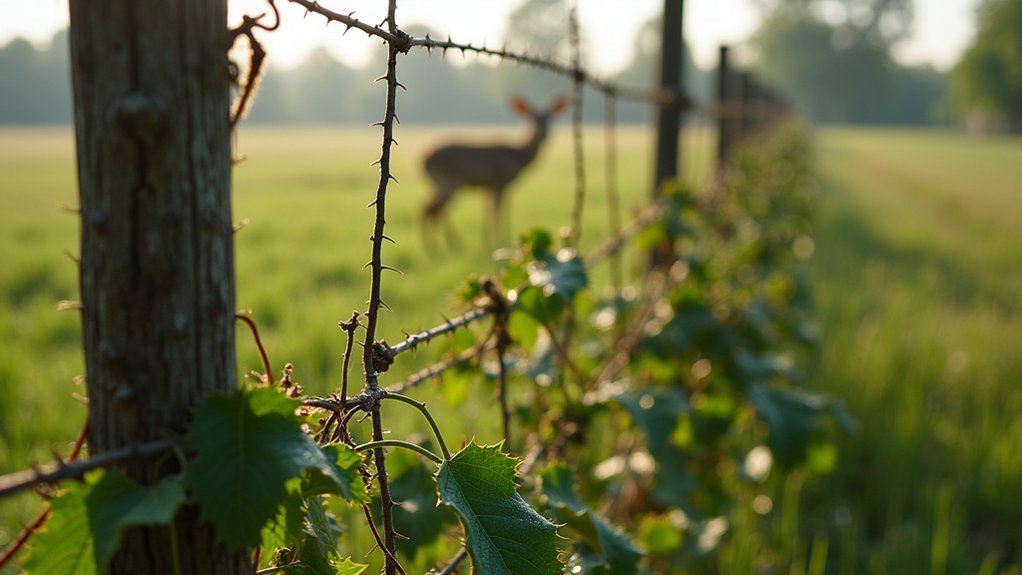Deer hate bitter plant fences because of their highly developed sense of smell that detects unpleasant compounds in plants like alkaloids and tannins. This aversion is an evolutionary survival mechanism steering them away from potentially toxic vegetation. You’ll find deer consistently avoid gardens bordered with aromatic herbs like lavender, sage, and bitter shrubs like boxwood. By strategically combining textures and tastes in your garden barrier, you’ll create a natural defense system that keeps deer at bay year-round.
The Science Behind Deer Taste Preferences

While many gardeners focus on physical barriers to keep deer away, understanding the science of deer taste preferences offers a more elegant solution.
Deer possess an extraordinarily developed sense of smell that detects bitter compounds in plants, steering them toward sweeter alternatives. This natural aversion to bitterness is an evolutionary survival mechanism, as these compounds often signal potential toxicity.
Nature’s survival code: deer instinctively avoid bitter plants that could harm them, preferring sweeter vegetation instead.
When selecting Deer-Resistant Plants for your garden, consider species high in alkaloids and tannins—secondary metabolites that create the bitter taste deer avoid. These natural deer repellant qualities make bitter plants particularly effective barriers.
You’ll find deer consistently prefer plants with high water content and mild flavors, while avoiding those with strong scents or bitter profiles. By leveraging this biological preference, you’re fundamentally creating a fence that deer interpret as unpalatable or potentially harmful.
Building Natural Barriers With Bitter-Tasting Plants
Creating an effective deer barrier doesn’t require unsightly fencing when you strategically employ bitter-tasting plants throughout your landscape. You’ll establish a protective perimeter while enhancing your garden’s visual appeal.
- Position lavender, sage, and marigolds along garden borders to create a deer-resistant first line of defense.
- Plant aromatic herbs that mask the scent of tastier plants deer typically target.
- Establish dense hedges of bitter-tasting varieties to block deer sight lines and discourage exploration.
- Implement companion planting techniques that shield vulnerable species with naturally bitter neighbors.
- Incorporate diverse bitter-tasting plants to simultaneously repel deer and attract beneficial pollinators.
This natural approach works because deer avoid bitter flavors instinctively.
You’ll create not just a functional barrier but a beautiful, biodiversity-supporting garden that deters unwanted browsers while delighting human visitors.
Top Aromatic Shrubs That Repel Deer
You’ll find remarkable protection in your garden by strategically placing aromatic shrubs that naturally repel hungry deer with their pungent scents.
These powerful plant allies create an invisible scent barrier that deer won’t cross, effectively masking the appealing aromas of your prized flowers and vegetables.
Your landscape can transform into a deer-resistant sanctuary when you incorporate lavender, rosemary, sage, and thyme as living fence components that double as beautiful, fragrant additions to your outdoor space.
Nature’s Deer-Proof Aromas
Gardeners battling persistent deer problems often overlook nature’s most effective defense system: aromatic shrubs. These natural deer repellent plants create invisible barriers through scents that deer find offensive, protecting your garden without harsh chemicals.
When you incorporate aromatic shrubs strategically, you’re harnessing powerful volatile oils that:
- Mask the appealing scent of your vulnerable plants
- Create a fragrant perimeter that deters deer from entering
- Enhance your landscape while providing year-round protection
- Contain bitter compounds that deer instinctively avoid
- Work double-duty as both beautiful garden elements and functional deterrents
Lavender, Russian sage, boxwood and juniper stand out as particularly effective choices, creating not just a physical boundary but a sensory one that confuses and repels even the hungriest deer visitors.
Pungent Protection Strategy
A strategic arrangement of potent-smelling shrubs forms your front-line defense against persistent deer. Lavender, rosemary, and sage release powerful oils that overwhelm deer’s sensitive olfactory system, creating an invisible barrier they’re reluctant to cross.
These aromatic shrubs serve dual purposes – they’re effective deer deterrents while attracting beneficial pollinators to enhance your garden’s ecosystem.
You’ll maximize protection by interplanting these fragrant varieties among more vulnerable plants, masking the appetizing scents deer typically pursue.
Consider juniper and boxwood as structural elements that maintain your landscape’s beauty while naturally repelling unwanted browsers.
The science is simple: deer rely heavily on their sense of smell to navigate and find food. When you introduce plants with pungent characteristics, you’re exploiting this sensitivity, creating a space they’ll actively avoid.
Scent-Barrier Plants
While creating an effective deer-resistant landscape requires strategy, incorporating specific aromatic shrubs forms your most powerful defense line.
These plants act as natural deer fencing through their potent scents that mask more appealing plants nearby.
- Boxwood and Juniper release volatile oils that repel deer with their strong fragrance
- Lavender and Rosemary protect neighboring plants by masking their appetizing scents
- Butterfly Bush and Spirea create bitter-tasting barriers deer naturally avoid
- Companion planting enhances garden beauty while utilizing natural repellent properties
- Dense plantings make your garden less visible and accessible to browsing deer
You’ll find these aromatic shrubs not only repel deer effectively but also add beautiful structure to your landscape, proving that functional protection can double as aesthetic enhancement.
Creating Layered Defense Perimeters for Gardens

Creating an effective natural border strategy against deer begins with strategically planting aromatic deterrents like Boxwood and Russian Sage around your garden’s perimeter.
You’ll strengthen this defense by developing multi-zone plant defenses that combine taller visual barriers such as Sky Pencil Holly with pungent middle-layer plants like Lavender to mask the scent of your valuable garden specimens.
For maximum protection, you can enhance these botanical barriers with physical fencing, creating a thorough system that deters deer through multiple sensory obstacles.
Natural Border Strategy
Because deer prefer clear paths and open visibility, strategic layered defense perimeters offer an effective, aesthetic solution for protecting your garden.
You’re fundamentally creating a living deer fence by combining plants they find unappealing with design techniques that exploit their natural caution.
- Plant boxwood, spirea, and butterfly bush around your garden’s exterior to form a natural barrier that deters deer.
- Intersperse aromatic herbs like lavender and rosemary to mask scents of tastier plants.
- Use dense planting techniques to block deer sightlines, keeping deer confused and hesitant.
- Create multiple height layers from groundcovers to taller shrubs for a more complex defensive barrier.
- Maintain your perimeter through regular pruning and replacing any damaged plants that compromise the barrier’s effectiveness.
Multi-Zone Plant Defenses
Successful defense against deer requires more than a single line of deterrent plants—you’ll need a strategic multi-zone approach to truly protect your garden. Create layered perimeters using shrubs that deer avoid, placing strong-scented varieties like Juniper and Spirea at outer boundaries to keep deer away.
| Zone | Plant Types | Function |
|---|---|---|
| Outer | Juniper, Spirea | Strong scent barrier |
| Middle | Boxwood, Butterfly Bush | Visual confusion |
| Inner | Tall ornamentals, Short herbs | Protect vulnerable plants |
Mix taller plants with shorter varieties in your inner zones to disrupt feeding patterns and confuse approaching deer. Remember to regularly refresh your plant selections, as deer can adapt to familiar scents over time. This all-encompassing strategy forces deer to navigate multiple deterrent layers, making your garden far less appealing than neighboring properties.
Seasonal Effectiveness of Plant-Based Deer Deterrents
While many gardeners rely on fencing or chemical repellents, plant-based deer deterrents offer a natural, aesthetically pleasing alternative that varies in effectiveness throughout the year.
You’ll notice deer avoid certain shrubs and trees due to their bitter taste or pungent aroma, but this avoidance isn’t consistent across seasons.
- Spring and early summer: Maximum effectiveness when bitter plants are in full growth
- Fall: Decreased effectiveness during rutting season when deer are more active and hungry
- Winter: Lowest protection when food is scarce and deer become less selective
- Early spring: Strategic planting of boxwood and spirea creates reliable barriers
- Year-round: Combining bitter plants with fragrant herbs confuses deer’s sensory perception
Understanding these seasonal patterns helps you plan your garden defense strategy, adjusting plant selections to maintain protection when deer pressure intensifies.
Combining Texture and Taste to Maximize Deterrence

Creating an effective deer deterrent system requires understanding how multiple sensory barriers work together to protect your garden. Deer hate plants with bitter flavors combined with rough textures—a powerful one-two punch to keep them away from your prized vegetation.
| Plant Type | Texture Feature | Taste Feature |
|---|---|---|
| Boxwood | Coarse leaves | Bitter sap |
| Juniper | Prickly needles | Strong aroma |
| Floss Flower | Fuzzy foliage | Unpalatable compounds |
| Verbena | Rough stems | Bitter flavor |
| Spiny Plants | Sharp thorns | Bitter aftertaste |
Native Bitter Plants for Regional Deer Resistance
Beyond texture combinations, regional native plants offer a powerful way to strengthen your deer-resistant garden.
Native bitter plants have evolved alongside local deer populations, developing potent compounds that signal “danger” to browsing wildlife.
You’ll find these native deterrents particularly effective because:
- They’re already adapted to your local soil and climate conditions
- Their bitter compounds specifically target deer’s sensitive taste receptors
- You won’t need chemical repellents when using these natural alternatives
- Dense plantings of these natives create effective “bitter barriers” around vulnerable areas
- They support local pollinators and beneficial insects while deterring deer
Strategic Placement for Maximum Deer Deterrence

Once you’ve selected the right plants, strategic placement becomes your most powerful tool for deer deterrence.
Create perimeter barriers using Boxwood or Juniper—their bitter aromas naturally repel deer while functioning as a living fence. Position Russian Sage or Lavender at the edges of flower beds to mask the scent of tastier plants deer might target.
To keep deer from accessing your garden, install thorny Spireas near entry points, creating physical obstacles they’ll avoid.
Enhance protection by mixing Cinquefoil and Butterfly Bush throughout your landscape, providing both visual and scent barriers that confuse deer’s senses.
Don’t let plants become predictable—regularly rotate bitter varieties to prevent deer from adapting to specific locations.
This dynamic approach maintains your defensive strategy’s effectiveness year-round.
Maintaining Your Living Deer Barrier Year-Round
While establishing a bitter plant fence provides initial protection, maintaining your living deer barrier requires consistent attention throughout the changing seasons.
Your dedication to proper care guarantees these bitter plants continue to effectively repel deer year after year.
- Regularly prune your bitter plants to stimulate growth and enhance their unpalatable characteristics.
- Fertilize in early spring to promote healthy foliage that maximizes natural bitterness.
- Rotate different plants within your barrier every few years to prevent deer adaptation.
- Monitor fence health and promptly replace any dead or diseased plants.
- Apply organic mulch around the base to retain moisture and suppress competing weeds.
This maintenance routine strengthens your living fence’s deterrent properties while keeping plants vigorous.
With consistent care, your bitter plant barrier will maintain its effectiveness against hungry deer regardless of season.
Frequently Asked Questions
What Smell Do Deer Absolutely Hate?
Deer absolutely hate predator urine scents, rotten egg smells, garlic, onions, hot peppers, and strong-smelling herbs like rosemary and sage. You’ll find they’ll avoid areas with these potent, threatening odors.
What Plant Do Deer Hate the Most?
Deer hate aromatic herbs like lavender, rosemary, and Russian sage the most. You’ll find they particularly avoid plants with strong scents, bitter tastes, or rough textures that make chewing unpleasant for them.
What Is the Best Fence to Keep Out Deer?
Your best deer fence should be 7-8 feet tall since they’ll jump lower barriers. You’ll get good results with thin-mesh wire on slim posts or electric fencing. Add reflective materials or combine with thorny hedges for extra protection.
Do Coffee Grounds Keep Deer Away From Plants?
Coffee grounds can help deter deer from your plants due to their bitter taste and strong smell. You’ll need to reapply them after rain and combine with other methods for best results.
In Summary
You’ve got all the tools to create a living fence that deer won’t touch. By strategically planting layers of bitter-tasting, aromatic plants around your garden, you’ll establish a natural barrier that works year-round. Remember to select native varieties suited to your region and maintain them regularly. With these bitter plant fences, you’ll protect your precious plants while maintaining an attractive landscape that deer will happily avoid.





Leave a Reply